牛津译林版(2019)必修 第三册Unit 1 Nature in the balance Grammar and usage 课件(共36张PPT)
文档属性
| 名称 | 牛津译林版(2019)必修 第三册Unit 1 Nature in the balance Grammar and usage 课件(共36张PPT) |
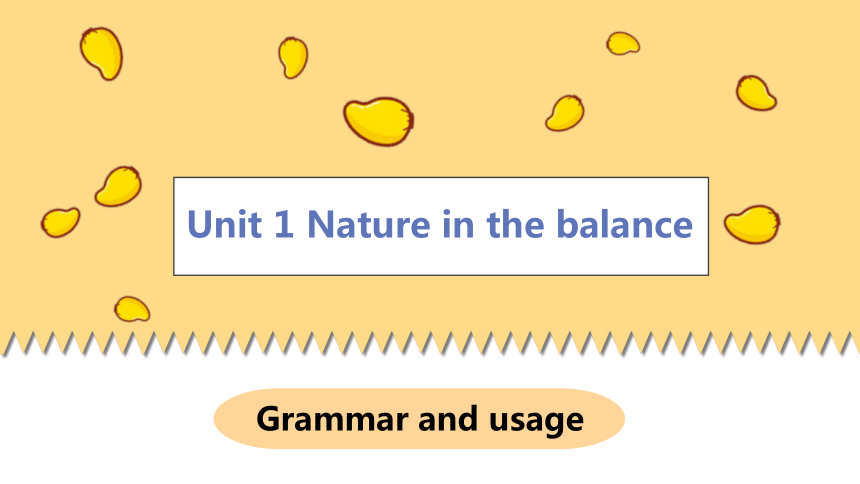
|
|
| 格式 | pptx | ||
| 文件大小 | 3.0MB | ||
| 资源类型 | 教案 | ||
| 版本资源 | 牛津译林版(2019) | ||
| 科目 | 英语 | ||
| 更新时间 | 2024-04-17 20:19:59 | ||
图片预览

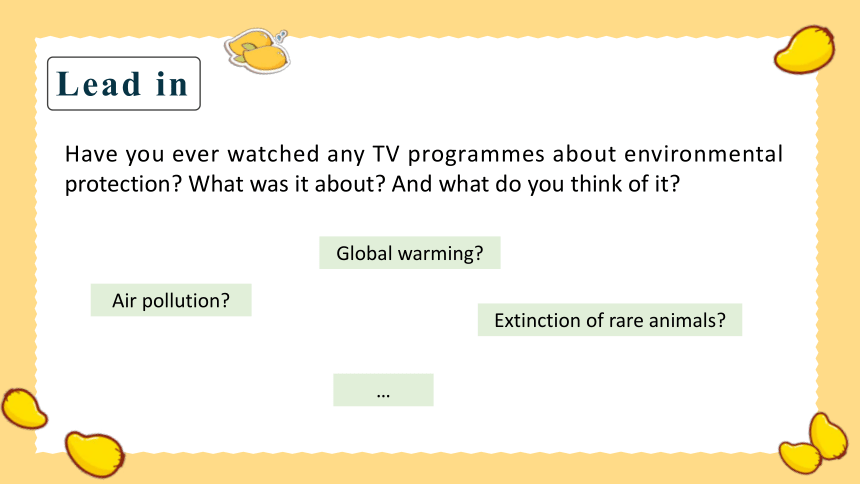

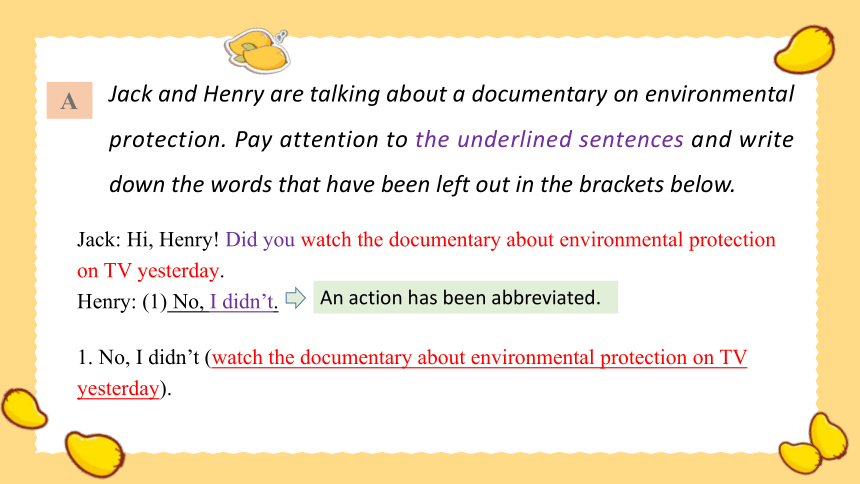
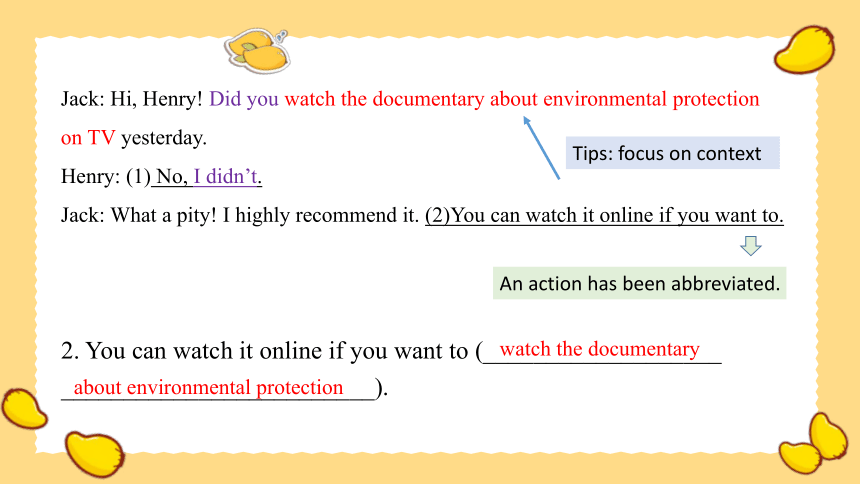

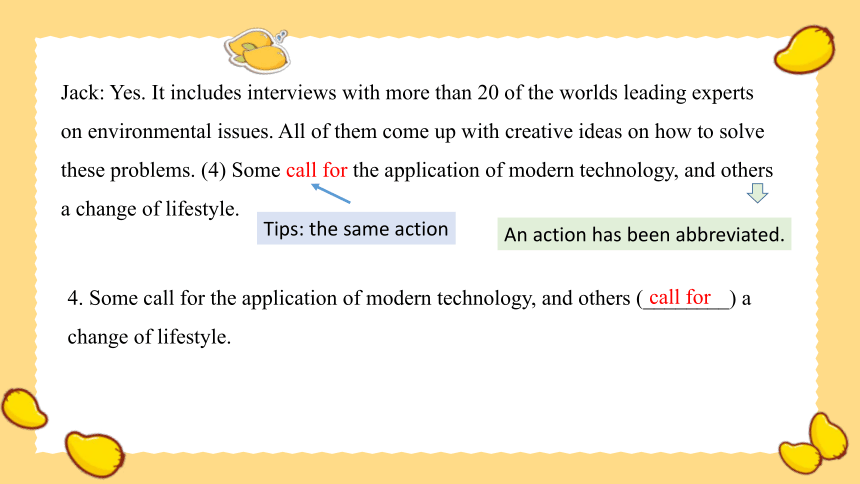

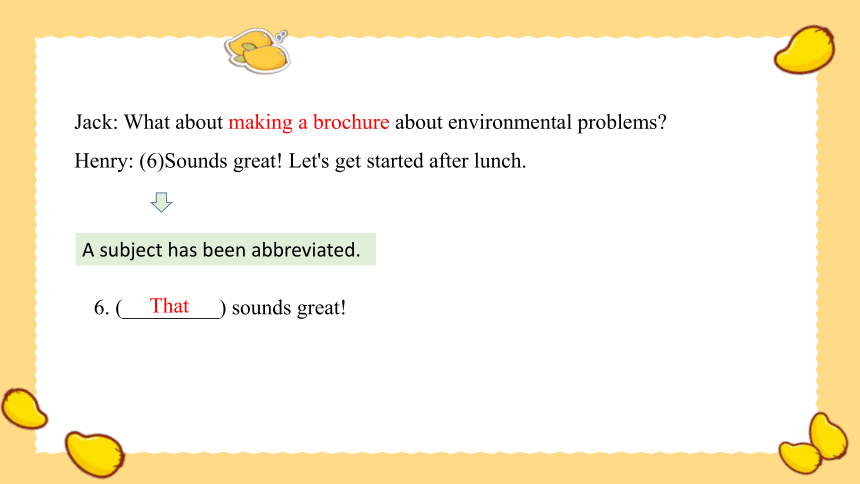
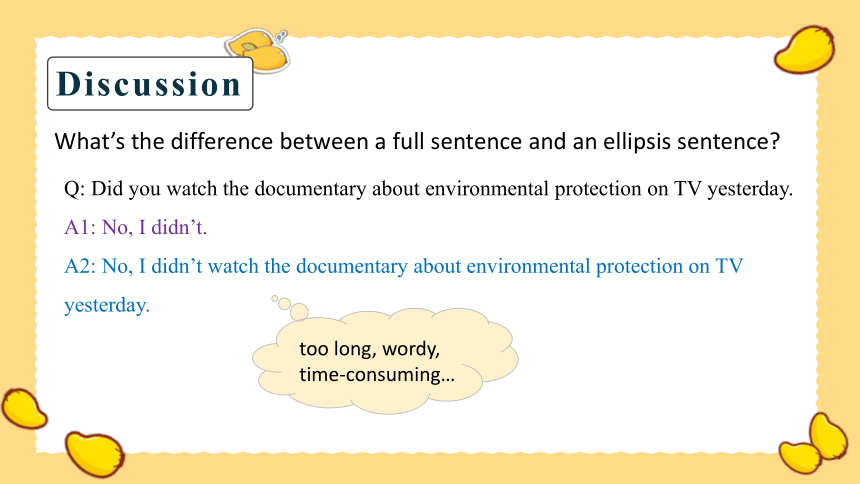
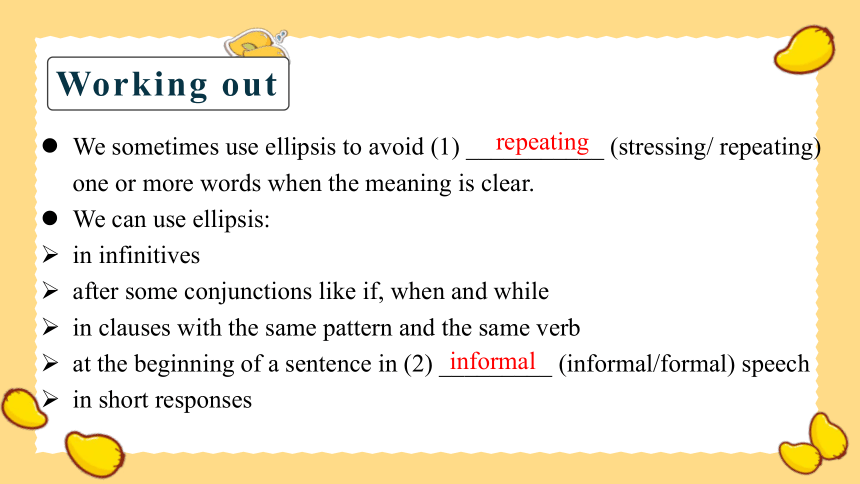
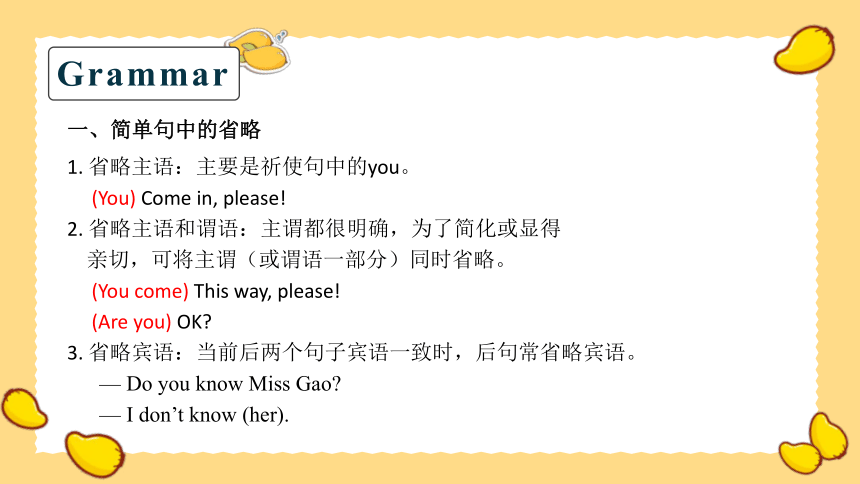
文档简介
(共36张PPT)
Unit 1 Nature in the balance
Grammar and usage
Lead in
Have you ever watched any TV programmes about environmental protection What was it about And what do you think of it
Air pollution
Global warming
Extinction of rare animals
…
Jack and Henry are talking about a documentary on environmental protection. Pay attention to the underlined sentences and write down the words that have been left out in the brackets below.
A
How did Jack feel when he watched the documentary
What do the leading experts suggest doing to solve the environmental problems
Exploring the rules
Jack and Henry are talking about a documentary on environmental protection. Pay attention to the underlined sentences and write down the words that have been left out in the brackets below.
A
Jack: Hi, Henry! Did you watch the documentary about environmental protection on TV yesterday.
Henry: (1) No, I didn’t.
1. No, I didn’t (watch the documentary about environmental protection on TV yesterday).
An action has been abbreviated.
Jack: Hi, Henry! Did you watch the documentary about environmental protection on TV yesterday.
Henry: (1) No, I didn’t.
Jack: What a pity! I highly recommend it. (2)You can watch it online if you want to.
2. You can watch it online if you want to (___________________ _________________________).
An action has been abbreviated.
Tips: focus on context
watch the documentary
about environmental protection
Jack: …It’s about some of the worst environmental problems we’re facing today. Global warming, for example, is a major problem caused by greenhouse gases. It may lead to extreme weather events: droughts, heatwaves and so on. (3) I felt worried when watching the documentary.
3. I felt worried when(_________) watching the documentary
a subject and a verb have been abbreviated.
Tips: the same subject
I was
Jack: Yes. It includes interviews with more than 20 of the worlds leading experts on environmental issues. All of them come up with creative ideas on how to solve these problems. (4) Some call for the application of modern technology, and others a change of lifestyle.
4. Some call for the application of modern technology, and others (________) a change of lifestyle.
An action has been abbreviated.
Tips: the same action
call for
Henry: I wish we could also do something to help. (5)Got any ideas
5. (________________) got any ideas
A subject and auxiliary verb have been abbreviated.
Tips: the object of the conversation
Have you
Jack: What about making a brochure about environmental problems
Henry: (6)Sounds great! Let's get started after lunch.
6. (_________) sounds great!
A subject has been abbreviated.
That
What’s the difference between a full sentence and an ellipsis sentence
Q: Did you watch the documentary about environmental protection on TV yesterday.
A1: No, I didn’t.
A2: No, I didn’t watch the documentary about environmental protection on TV yesterday.
too long, wordy, time-consuming…
Discussion
We sometimes use ellipsis to avoid (1) ___________ (stressing/ repeating) one or more words when the meaning is clear.
We can use ellipsis:
in infinitives
after some conjunctions like if, when and while
in clauses with the same pattern and the same verb
at the beginning of a sentence in (2) _________ (informal/formal) speech
in short responses
repeating
informal
Working out
1. 省略主语:主要是祈使句中的you。
(You) Come in, please!
2. 省略主语和谓语:主谓都很明确,为了简化或显得
亲切,可将主谓(或谓语一部分)同时省略。
(You come) This way, please!
(Are you) OK
3. 省略宾语:当前后两个句子宾语一致时,后句常省略宾语。
— Do you know Miss Gao
— I don’t know (her).
一、简单句中的省略
Grammar
在由and或but连接的并列句中,常省略重复的部分。
1. 省略共同的主或宾。
Tom picked up a book on the floor and (Tom) handed it to
his teacher.
2. 若主语不同,而谓语部分的系动词、助动词或情态动词相同,则省略后面相同的部分。
Jack must have been playing football and Mary (must have been) doing her homework.
二、并列句中的省略
3. 若主谓相同,省略后面的主谓成分。
His advice made me happy, but (his advice made) Jim angry.
4. 若主语不同,但主要动词及后续部分相同,则省略主要动
词及后续部分。
He has a knowledge of first aid but his friend doesn’t (have a knowledge of first aid).
二、并列句中的省略
1. 状语从句的省略
(1) 在when, while, if, as if, though, although, as, until, once, whether, unless, whenever等引导的状语从句中,当从句主语和主句的主语相同且从句谓语中含有系动词be或从句的主语为it时,从句中主语和be动词常被省略。
You’d better look out when (you are) crossing the street.
Whenever (it is) possible, they would stop him and ask him the three questions.
(2) 当比较状语从句的谓语与主句相同时,从句中的谓语常被省略。
He runs as fast as Bob (runs).
They don’t use more water than (it is) necessary.
三、主动复合句中的省略
2. 定语从句的省略
(1) 在限制性定语从句中,作宾语用的关系代词whom, who, which, that可省略。
The exact year (which/ that) Angela and her family spent together in China was 2008.
He is the man (who/ whom/ that) you can depend on.
(2) 修饰way的关系词that/ in which可以省略。
The way (in which/ that) he speaks to us is really annoying.
3. 宾语从句的省略
(1) 由that引导的宾语从句,that一般可以省略;但如果动词接两个或两个以上that引导的宾语从句时,that可以省略。
He said (that) the text was very important and that we should learn it by heart.
(2) when, where, how和why引导的宾从有时可以仅保留引导词。
I know that a movie star will come to our city but I don’t know when (he will come to our city).
1. 不定式作某些动词的宾语补足语或主语补足语,且在上文中已经出现时,可省略to后面的成分,这些动词常见的有:ask, tell, advise, force, persuade, wish, allow, permit, forbid, expect, order, warn等。如:The boy wanted to ride his bicycle in the street, but his mother told him not to (ride it).
2. 在感官动词后作宾语补足语的不定式省略to。
I saw the car (to) drive up outside the police station.
3. 在使役动词make, let, have等后作宾语补足语的不定式省略to。
四、其他的省略
4. 在rather than等表示“与其……不如”短语后的不定式省略to。
5. 介词but / except前边有实义动词do的某种形式时,其后的不定式省略to。
He can do nothing but / except lie down and sleep.
6. 在can not but do sth., can’t choose but do sth., can not help but do sth.句式中,but后跟的不定式(短语)省略to。
7. 习惯上的省略
由固定短语引导的疑问句。
What about having a game of chess
What if it’s raining
习惯性的交际用语。
Not at all.
No matter.
Thanks.
What rule does each sentence use
No, I didn’t (watch the documentary about environmental protection on TV yesterday).
You can watch it online if you want to (watch the documentary about environmental protection).
I felt worried when (I was) watching the documentary.
Some call for the application of modern technology, and others (call for) a change of lifestyle.
(Have you) got any ideas
(It/ That) sounds great!
In short responses
In infinitives
After some conjunctions like if, when and while
In clauses with the same pattern and the same verb
At the beginning of a sentence in informal speech
Review
What is ellipsis
When can we use ellipsis
What’s the function of ellipsis
The act of leaving out a word or words from a sentence deliberately.
When the meaning can still be understood without using a word or certain words.
An efficient way to make sentences concise.
Summary
Find the mistakes and rewrite the sentences using ellipsis.
B1
I cannot watch the documentary this weekend though I would like.
Cows live on land and fish the water.
I cannot watch the documentary this weekend though I would like to.
I would like.
the water.
Cows live on land and fish in the water.
Applying the rules
The Amazon rainforest is smaller now than was 50 years ago.
He had planned to borrow a book on environmental protection, but he didn't do.
When taking photos of wildlife, every effort should be made to ensure that we keep away from the animals.
was 50 years ago.
didn’t do.
every effort should be made
When taking photos of wildlife, When taking photos of wildlife, we should make every effort to ensure that we keep away from the animals.
Jack is sharing with his classmates his experience of taking part in a forest clean-up activity. Use ellipsis where necessary. Put brackets around the word(s)that can be left out.
B2
In short responses
In infinitives
After some conjunctions like if, when and while
In clauses with the same pattern and the same verb
At the beginning of a sentence in informal speech
Last weekend, I took part in a forest clean-up activity. It was organized by Green Hope, an organization devoted to protecting forests. At first I didn’t want to take part in the forest clean-up activity , but then I thought, “What if nobody goes ” Our team leader, Joe, took us to a forest outside the city. I was sad to see litter everywhere. There was a “No littering is allowed here” sign at the entrance to the forest, but that didn’t stop people from throwing their rubbish on the ground.
(
)
(
)
Joe divided us into two groups: one group cleaned up the north side of the forest, and the other group cleaned up the south side of the forest. We worked for several hours and we were happy to see that the forest looked cleaner than it had looked before. It was absolutely worth our effort! There’ll be another clean-up activity in the green belt next Saturday. You can find Joe and sign up if you’re willing to help. Everyone who takes part in the activity will receive a medal. I’ll join you too if I have time.
(
)
(
)
(
)
(
)
(
)
(
)
Let’s continue Jack and Henry’s conversation on designing a brochure about protecting the environment by using ellipsis where possible.
Role playing
In pairs, describe the pictures below using ellipsis to call for the protection of the environment. Use the example to help you. You can draw a picture and think of a slogan.
B3
a word or phrase that is easy to remember, used for example in advertising to attract people's attention or to suggest an idea quickly
Practice
A smiling kid is drawing a green tree: ideal world
Blue sky and shining sunshine: good environment
Polluted air, dark sky: serious pollution
Factories and dead trees: cause and consequence of pollution
When the water is too dirty to drink and the air too polluted to breathe, will you be able to look at your children and say, “what a beautiful world!”
How to make a slogan
“Give a hand to wildlife”
A bicycle, made by leaves, daily transport, eco-friendly
Upper leaf: green, green energy, trees, clean sky
Lower leaf: yellow, factories, polluted air, no creatures
We should use public or eco-friendly transport for protecting environment
Protecting environment is urgent, new energy new life
Your turn
Show us your calls, and give some suggestions to improve the calls.
Review the rules of ellipsis and draw a picture and think of a slogan to call for the protection of the environment.
Homework
感 谢 观 看
Unit 1 Nature in the balance
Grammar and usage
Lead in
Have you ever watched any TV programmes about environmental protection What was it about And what do you think of it
Air pollution
Global warming
Extinction of rare animals
…
Jack and Henry are talking about a documentary on environmental protection. Pay attention to the underlined sentences and write down the words that have been left out in the brackets below.
A
How did Jack feel when he watched the documentary
What do the leading experts suggest doing to solve the environmental problems
Exploring the rules
Jack and Henry are talking about a documentary on environmental protection. Pay attention to the underlined sentences and write down the words that have been left out in the brackets below.
A
Jack: Hi, Henry! Did you watch the documentary about environmental protection on TV yesterday.
Henry: (1) No, I didn’t.
1. No, I didn’t (watch the documentary about environmental protection on TV yesterday).
An action has been abbreviated.
Jack: Hi, Henry! Did you watch the documentary about environmental protection on TV yesterday.
Henry: (1) No, I didn’t.
Jack: What a pity! I highly recommend it. (2)You can watch it online if you want to.
2. You can watch it online if you want to (___________________ _________________________).
An action has been abbreviated.
Tips: focus on context
watch the documentary
about environmental protection
Jack: …It’s about some of the worst environmental problems we’re facing today. Global warming, for example, is a major problem caused by greenhouse gases. It may lead to extreme weather events: droughts, heatwaves and so on. (3) I felt worried when watching the documentary.
3. I felt worried when(_________) watching the documentary
a subject and a verb have been abbreviated.
Tips: the same subject
I was
Jack: Yes. It includes interviews with more than 20 of the worlds leading experts on environmental issues. All of them come up with creative ideas on how to solve these problems. (4) Some call for the application of modern technology, and others a change of lifestyle.
4. Some call for the application of modern technology, and others (________) a change of lifestyle.
An action has been abbreviated.
Tips: the same action
call for
Henry: I wish we could also do something to help. (5)Got any ideas
5. (________________) got any ideas
A subject and auxiliary verb have been abbreviated.
Tips: the object of the conversation
Have you
Jack: What about making a brochure about environmental problems
Henry: (6)Sounds great! Let's get started after lunch.
6. (_________) sounds great!
A subject has been abbreviated.
That
What’s the difference between a full sentence and an ellipsis sentence
Q: Did you watch the documentary about environmental protection on TV yesterday.
A1: No, I didn’t.
A2: No, I didn’t watch the documentary about environmental protection on TV yesterday.
too long, wordy, time-consuming…
Discussion
We sometimes use ellipsis to avoid (1) ___________ (stressing/ repeating) one or more words when the meaning is clear.
We can use ellipsis:
in infinitives
after some conjunctions like if, when and while
in clauses with the same pattern and the same verb
at the beginning of a sentence in (2) _________ (informal/formal) speech
in short responses
repeating
informal
Working out
1. 省略主语:主要是祈使句中的you。
(You) Come in, please!
2. 省略主语和谓语:主谓都很明确,为了简化或显得
亲切,可将主谓(或谓语一部分)同时省略。
(You come) This way, please!
(Are you) OK
3. 省略宾语:当前后两个句子宾语一致时,后句常省略宾语。
— Do you know Miss Gao
— I don’t know (her).
一、简单句中的省略
Grammar
在由and或but连接的并列句中,常省略重复的部分。
1. 省略共同的主或宾。
Tom picked up a book on the floor and (Tom) handed it to
his teacher.
2. 若主语不同,而谓语部分的系动词、助动词或情态动词相同,则省略后面相同的部分。
Jack must have been playing football and Mary (must have been) doing her homework.
二、并列句中的省略
3. 若主谓相同,省略后面的主谓成分。
His advice made me happy, but (his advice made) Jim angry.
4. 若主语不同,但主要动词及后续部分相同,则省略主要动
词及后续部分。
He has a knowledge of first aid but his friend doesn’t (have a knowledge of first aid).
二、并列句中的省略
1. 状语从句的省略
(1) 在when, while, if, as if, though, although, as, until, once, whether, unless, whenever等引导的状语从句中,当从句主语和主句的主语相同且从句谓语中含有系动词be或从句的主语为it时,从句中主语和be动词常被省略。
You’d better look out when (you are) crossing the street.
Whenever (it is) possible, they would stop him and ask him the three questions.
(2) 当比较状语从句的谓语与主句相同时,从句中的谓语常被省略。
He runs as fast as Bob (runs).
They don’t use more water than (it is) necessary.
三、主动复合句中的省略
2. 定语从句的省略
(1) 在限制性定语从句中,作宾语用的关系代词whom, who, which, that可省略。
The exact year (which/ that) Angela and her family spent together in China was 2008.
He is the man (who/ whom/ that) you can depend on.
(2) 修饰way的关系词that/ in which可以省略。
The way (in which/ that) he speaks to us is really annoying.
3. 宾语从句的省略
(1) 由that引导的宾语从句,that一般可以省略;但如果动词接两个或两个以上that引导的宾语从句时,that可以省略。
He said (that) the text was very important and that we should learn it by heart.
(2) when, where, how和why引导的宾从有时可以仅保留引导词。
I know that a movie star will come to our city but I don’t know when (he will come to our city).
1. 不定式作某些动词的宾语补足语或主语补足语,且在上文中已经出现时,可省略to后面的成分,这些动词常见的有:ask, tell, advise, force, persuade, wish, allow, permit, forbid, expect, order, warn等。如:The boy wanted to ride his bicycle in the street, but his mother told him not to (ride it).
2. 在感官动词后作宾语补足语的不定式省略to。
I saw the car (to) drive up outside the police station.
3. 在使役动词make, let, have等后作宾语补足语的不定式省略to。
四、其他的省略
4. 在rather than等表示“与其……不如”短语后的不定式省略to。
5. 介词but / except前边有实义动词do的某种形式时,其后的不定式省略to。
He can do nothing but / except lie down and sleep.
6. 在can not but do sth., can’t choose but do sth., can not help but do sth.句式中,but后跟的不定式(短语)省略to。
7. 习惯上的省略
由固定短语引导的疑问句。
What about having a game of chess
What if it’s raining
习惯性的交际用语。
Not at all.
No matter.
Thanks.
What rule does each sentence use
No, I didn’t (watch the documentary about environmental protection on TV yesterday).
You can watch it online if you want to (watch the documentary about environmental protection).
I felt worried when (I was) watching the documentary.
Some call for the application of modern technology, and others (call for) a change of lifestyle.
(Have you) got any ideas
(It/ That) sounds great!
In short responses
In infinitives
After some conjunctions like if, when and while
In clauses with the same pattern and the same verb
At the beginning of a sentence in informal speech
Review
What is ellipsis
When can we use ellipsis
What’s the function of ellipsis
The act of leaving out a word or words from a sentence deliberately.
When the meaning can still be understood without using a word or certain words.
An efficient way to make sentences concise.
Summary
Find the mistakes and rewrite the sentences using ellipsis.
B1
I cannot watch the documentary this weekend though I would like.
Cows live on land and fish the water.
I cannot watch the documentary this weekend though I would like to.
I would like.
the water.
Cows live on land and fish in the water.
Applying the rules
The Amazon rainforest is smaller now than was 50 years ago.
He had planned to borrow a book on environmental protection, but he didn't do.
When taking photos of wildlife, every effort should be made to ensure that we keep away from the animals.
was 50 years ago.
didn’t do.
every effort should be made
When taking photos of wildlife, When taking photos of wildlife, we should make every effort to ensure that we keep away from the animals.
Jack is sharing with his classmates his experience of taking part in a forest clean-up activity. Use ellipsis where necessary. Put brackets around the word(s)that can be left out.
B2
In short responses
In infinitives
After some conjunctions like if, when and while
In clauses with the same pattern and the same verb
At the beginning of a sentence in informal speech
Last weekend, I took part in a forest clean-up activity. It was organized by Green Hope, an organization devoted to protecting forests. At first I didn’t want to take part in the forest clean-up activity , but then I thought, “What if nobody goes ” Our team leader, Joe, took us to a forest outside the city. I was sad to see litter everywhere. There was a “No littering is allowed here” sign at the entrance to the forest, but that didn’t stop people from throwing their rubbish on the ground.
(
)
(
)
Joe divided us into two groups: one group cleaned up the north side of the forest, and the other group cleaned up the south side of the forest. We worked for several hours and we were happy to see that the forest looked cleaner than it had looked before. It was absolutely worth our effort! There’ll be another clean-up activity in the green belt next Saturday. You can find Joe and sign up if you’re willing to help. Everyone who takes part in the activity will receive a medal. I’ll join you too if I have time.
(
)
(
)
(
)
(
)
(
)
(
)
Let’s continue Jack and Henry’s conversation on designing a brochure about protecting the environment by using ellipsis where possible.
Role playing
In pairs, describe the pictures below using ellipsis to call for the protection of the environment. Use the example to help you. You can draw a picture and think of a slogan.
B3
a word or phrase that is easy to remember, used for example in advertising to attract people's attention or to suggest an idea quickly
Practice
A smiling kid is drawing a green tree: ideal world
Blue sky and shining sunshine: good environment
Polluted air, dark sky: serious pollution
Factories and dead trees: cause and consequence of pollution
When the water is too dirty to drink and the air too polluted to breathe, will you be able to look at your children and say, “what a beautiful world!”
How to make a slogan
“Give a hand to wildlife”
A bicycle, made by leaves, daily transport, eco-friendly
Upper leaf: green, green energy, trees, clean sky
Lower leaf: yellow, factories, polluted air, no creatures
We should use public or eco-friendly transport for protecting environment
Protecting environment is urgent, new energy new life
Your turn
Show us your calls, and give some suggestions to improve the calls.
Review the rules of ellipsis and draw a picture and think of a slogan to call for the protection of the environment.
Homework
感 谢 观 看
同课章节目录
- Unit 1 Nature in the balance
- Welcome to the unit
- Reading
- Grammar and usage
- Integrated skills
- Extended reading
- Project
- Unit 2 Natural disasters
- Welcome to the unit
- Reading
- Grammar and usage
- Integrated skills
- Extended reading
- Project
- Unit 3 The world online
- Welcome to the unit
- Reading
- Grammar and usage
- Integrated skills
- Extended reading
- Project
- Unit 4 Scientists who changed the world
- Welcome to the unit
- Reading
- Grammar and usage
- Integrated skills
- Extended reading
- Project
